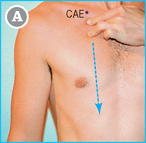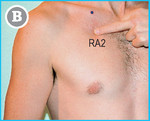6 Ribs (thorax)
Orientation and general presentation (Fig. 6.1)
The thorax includes 12 pairs of ribs (1–12; left ribs are numbered in Figure 6.1; the ninth, tenth and 11th left ribs are superimposed in this view). Each rib articulates anteriorly, through a costal cartilage, with either the sternum (13) for the first seven ribs, or with the rib above (for the eighth to tenth ribs). The two last ribs (the so-called floating ribs) do not show any anterior joints with the sternum, and ‘float’ in the soft tissue of the abdomen. Posteriorly, the ribs articulate with the thoracic vertebrae. The first pair of ribs is difficult to palpate because the ribs are located below the clavicle (14). The second pair of ribs articulates with the sternum at the level of the manubriosternal joint (SME; see p. 36). The seventh pair articulates with the sternum at the level of the xiphisternal joint (SXS; see p. 37). The lateral faces of the ribs are located on the lateral aspect of the thorax (RL4–RL10), vertically above the tubercle of the iliac crest (ICT; see p. 112) found on the ilium (15). The anterior part of the second to seventh ribs (RA2–RA7) can be palpated vertically below the anterior convexity of the clavicle (CAE; see p. 47). The center of the costal cartilage of the second to seventh ribs (RM2–RM7) is found vertically below the anterior edge of the sternoclavicular joint (CAS; see p. 49).
Ribs – Anterior aspect (RA2–RA7)[R,L]
Landmarks RA2–RA7
The anterior aspect of the second to seventh ribs is located below a vertical line running down from the anterior convexity of the clavicle (CAE) (see Fig. 6.1).
![]() The palpator is lateral to the sitting subject.
The palpator is lateral to the sitting subject.
![]() Put your middle finger between the forefinger and the annular finger.
Put your middle finger between the forefinger and the annular finger.
First locate CAE (see p. 47) and mark it.
Mark the center of the rib (here, RA2 on the second rib).
Stay updated, free articles. Join our Telegram channel

Full access? Get Clinical Tree











